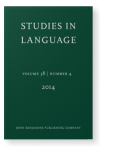Sonja Gipper
List of John Benjamins publications for which Sonja Gipper plays a role.
2022 The expression of directed caused accompanied motion events in Yurakaré: Semantics, pragmatics, and interactional variability Caused Accompanied Motion: Bringing and taking events in a cross-linguistic perspective, Margetts, Anna, Sonja Riesberg and Birgit Hellwig (eds.), pp. 101–146 | Chapter
This chapter gives an overview of the expression of directed caused accompanied motion events in Yurakaré (isolate, Bolivia) spoken discourse. Building on previous descriptive work by van Gijn (2005, 2006, 2011b), the chapter sets a focus on discourse frequencies of the relevant constructions,… read more
2020 Repeating responses as a conversational affordance for linguistic transmission: Evidence from Yurakaré conversations Studies in Language 44:2, pp. 281–326 | Article
Given that face-to-face interaction is an important locus for linguistic transmission (Enfield 2008: 297), it is argued in this paper that conversational structure must provide affordances (Gibson 1979) for transmitting linguistic items. The paper focuses on repeats where an interactant… read more
2019 Chapter 9. Life of =ti: Use and grammaticalization of a clausal nominalizer in Yurakaré Nominalization in Languages of the Americas, Zariquiey, Roberto, Masayoshi Shibatani and David W. Fleck (eds.), pp. 363–390 | Chapter
In this paper, we investigate the uses of the clausal nominalizer =ti in Yurakaré, a linguistic isolate spoken in Bolivia. Clauses nominalized with =ti can serve a variety of functions: filling an argument position, relativization, forming the complement of a complement-taking verb, and expressing… read more
2018 Chapter 10. From similarity to evidentiality: Uncertain visual/perceptual evidentiality in Yurakaré and other languages Evidence for Evidentiality, Foolen, Ad, Helen de Hoop and Gijs Mulder (eds.), pp. 257–280 | Chapter
This chapter argues that the synchronic uses of the Yurakaré (isolate, central Bolivia) polyfunctional suffix ‑shi plausibly reflect a diachronic path of semantic extension, first from a derivational suffix expressing similarity to an uncertain visual/perceptual evidential, and from there to an… read more
2014 Intersubjective evidentials in Yurakaré: Evidence from conversational data and a first step toward a comparative perspective Studies in Language 38:4, pp. 792–835 | Article
This paper argues that evidentials in Yurakaré (Bolivia, isolate) have an intersubjective dimension in that they do not only express the speaker’s information source, but also convey the speaker’s assumptions about the addressee’s perspective on the information. To describe these intersubjective… read more
2014 From inferential to mirative: An interaction-based account of an emerging semantic extension Usage-Based Approaches to Language Change, Coussé, Evie and Ferdinand von Mengden (eds.), pp. 83–116 | Article
In Yurakaré (isolate, Bolivia), the inferential evidential =tiba has a secondary use in a mirative construction marking unexpected information. This paper proposes that the synchronic interactional uses of =tiba plausibly reflect a diachronic process, namely an emerging semantic extension from… read more
2009 Irrealis in Yurakaré and other languages: On the cross-linguistic consistency of an elusive category Cross-linguistic Semantics of Tense, Aspect, and Modality, Hogeweg, Lotte, Helen de Hoop and Andrej L. Malchukov (eds.), pp. 155–178 | Article
The linguistic category of irrealis does not show stable semantics across languages. This makes it difficult to formulate general statements about this category, and it has led some researchers to reject irrealis as a cross-linguistically valid category. In this paper we look at the semantics of… read more






